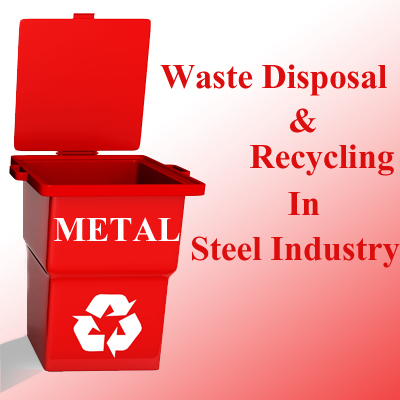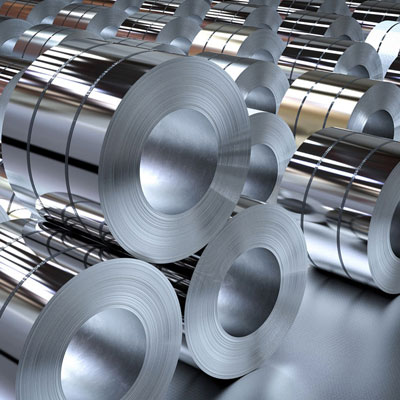Waste Disposal and Recycling in Steel Industry

Steel is a versatile commodity that plays a major part in everyday life—from food cans, household containers, automobiles, and office buildings. Steel makes up the largest category of metals in the municipal solid waste (MSW) and industrial waste streams. Steel since ages has been a recycled material throughout the world.
Solid wastes in steel plants are essential by-products generated during various processing steps involved in the production of iron and steel. Solid wastes generated by integrated iron and steel works cause environmental pollution and therefore must be discarded. Until the last decade, the slag, dust and sludge generated by integrated steel plants was called waste", but now this term has been replaced with “by-product” due to intensive re-utilization of these wastes.
In 2010, the United States generated about 2.7 million tons of steel as containers and packaging in the MSW (Municipal Solid Waste) stream, as well as another 14.2 million tons of ferrous metals, which include iron and steel, as durable goods—representing 6.8 percent of total MSW generation in 2010.
The waste generated by steel industry not only causes health problems but also causes lot of environmental degradation. Therefore it becomes very important for the industries who are involved in the manufacture of steel to look for the methods that ensures safe disposal and recycling of waste.
| Also Read: Sustainable Waste Disposal and Recycling Strategies in the Steel Industry |
Methods used by various Steel Industries for the waste disposal:
Jindal Steel and Power Limited (JSPL) through extensive R & D activities have identified various solid wastes that could be used as productive inputs. The company pursues the policy of three R’s -- Recycle, Reduce and Reuse – to manage its waste. Many innovative projects under “Wealth from Waste” have been implemented for solid waste utilization. The main objective of the company is to transform solid waste into wealth in order to benefit from it.
The Parsada dump yard of JSPL stores solid waste on a temporary basis and then for further re-use, the solid waste is transported to the sinter plant.
Recently BMP (bio-methanation plant) was installed in association with BARC, Mumbai for bio-gas production. Bio-degradable from residential area is collected, segregated and fed in this 3 TPD BMP. It is the only plant of its kind in whole of Chhattisgarh. As per the Fly Ash Notification Law, which came into effect from 1999, JSPL has attained Fly Ash Utilisation Status. Steps have already been taken to achieve a level of 100% utilization of the same. The ash is partly used for brick making, ash dyke rising, road and embankment construction, cement manufacturing and land filling.
| Also Read: Why Is Sustainable Steel Industry Waste Management Important? |
Another major steel industry, Tata steel, has made reducing emissions a priority for the Company. Operational investments, such as the new H Blast Furnace in Jamshedpur, seek to employ state-of-the-art equipment, which improves efficiency and reduces pollution.
Some steps taken by Tata Steel, India are:
- 89.6% of solid waste generated from Steel Works is recycled or reused.
- 17% of the solid waste generated, amounting to approximately 6, 12,300 tonnes in 2008-09 was used to fill low-lying areas and for peripheral road construction around Jamshedpur.
Tangshan Iron & Steel, the flagship site of China’s largest steelmaker, Hebei Iron & Steel (HBIS) Group, the second largest producer of steel in the world. In recent years Tangshan Iron & Steel has made environmental improvements in power consumption, water use and by-product recycling.
Tangshan Iron carried out a large scale investment in plant energy savings and emission reduction technology. Two new 450 cubic meter blast furnaces were dismantled, reducing dust emissions by 1600 tons one year, and sulfur dioxide reduced by 3000 tons.
In 2011 the company implemented 25 energy saving projects and invested 2.68 billion RMB ($400m) in environmental governance and energy conservation.
| Also Read: Closing the Loop: Advanced Waste Management in the Steel Industry |
In 2012, Tangshan Steel signed a joint venture agreement with Harsco for the environmentally-beneficial handling and processing of steelmaking by-products. The new agreement will include advanced slag treatment processes for BOF and LAF slag’s, leading to significant reductions in environmental impact versus traditional methods, along with high-efficiency metal recovery and the manufacture of co products from the residual slag’s, for reuse into the cement, concrete and road base infrastructure markets.
Apart from these waste disposal methods used by the companies, recycling is also becoming very important. Recycling is a process using materials (waste) into new products to prevent waste of potentially useful materials, reduce the consumption of fresh raw materials, reduce energy usage, reduce air pollution (from incineration) and water pollution (from landfilling) by reducing the need for "conventional" waste disposal, and lower greenhouse gas emissions as compared to plastic production. Recycling is a key component of modern waste reduction and is the third component of the "Reduce, Reuse, and Recycle" waste hierarchy.
One such company Schnitzer Steel Industries Inc, founded in 1906 as a one-man scrap metal operation, is now one of the largest recyclers of scrap metal, a leading provider of used and recycled auto parts and a manufacturer of finished steel products.
The company has also started joint venture with American Rail Marketing LL, Cherry City Metals, Plant Reclamation and United Metals.
The steel industry in North America has been recycling steel scrap for more than 150 years. The steel industry needs scrap to produce new steel, which ensures that all steel products contain anywhere from 25 percent up to 100 percent recycled content. It also is cheaper to recycle steel than it is to mine virgin ore to manufacture new steel. New ore is still mined in order to supplement production of steel and steel products.
Recovering steel not only saves money, but also dramatically reduces energy consumption, compared to making steel from virgin materials. In turn, this reduces the amount of greenhouse gases released in to the air during processing and manufacturing steel from virgin ore.
These are the few developments which have taken place in the waste disposal and recycling area, however with the growth in the manufacturing and production more developments and innovations will be senn in the near future.










